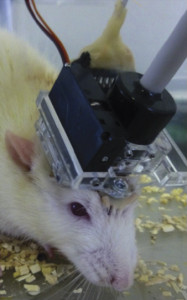THIS ARTICLE IS MORE THAN FIVE YEARS OLD
This article is more than five years old. Autism research — and science in general — is constantly evolving, so older articles may contain information or theories that have been reevaluated since their original publication date.

Getting ahead: A tiny motor sweeps an ultrasound probe across the gel-covered head of a rat, tracking blood flow through its brain.
A head-mounted device measures blood flow and electrical activity in the brains of rats as they roam their cages. The device, described 3 August in Nature Methods, may help researchers understand how brain activity goes awry in autism1.
People with autism show atypical brainwaves in certain situations, as measured by electroencephalography (EEG). And methods for tracking blood flow, such as functional magnetic resonance imaging (fMRI), have revealed altered connectivity in the brains of people with autism.
The new device combines EEG, which provides a readout of brain activity, with functional ultrasound, which uses high-frequency sound waves to trace the flow of blood across a large area of the brain. Together, the techniques reveal how different brain areas activate in synchrony, allowing researchers to map the strength of brain connections.
Because ultrasound waves pass poorly through bone, however, functional ultrasound requires researchers to remove a portion of a rat’s skull to expose its brain and conduct experiments while the rat is still anesthetized.
By contrast, the new contraption lets researchers perform studies in awake rats. Researchers remove a portion of an anesthetized rat’s skull, insert EEG electrodes and close the skull with a protective patch that allows ultrasound waves to pass freely. They can then record the rat’s brain activity after it recovers from the surgery and starts to move around.
A plexiglass mount affixed to the rat’s head holds a tiny motor and miniature ultrasound probe. A wire tethers the rat to a machine that allows the researchers to remotely move the probe over the patch and direct ultrasound waves to various parts of the rat’s brain while also recording its brainwaves.
At first, rats wearing the device are slightly slower than their unencumbered littermates as they run along a 7-foot track. But over time, the rats appear to get used to the device and catch up.
In one experiment, the device picked up slow brain waves associated with navigation in the hippocampus — a region involved in spatial memory. These signals were strongest as the rats approached maximum speeds. As expected, blood rushed into the hippocampus and other brain regions slightly after electrical activity peaked, as neuronal firing helps trigger blood flow to active brain areas.
The researchers also recorded brain activity during seizures in a rat model of epilepsy. They found that electrical activity patterns during seizures are sometimes uncoupled from blood flow. This finding underscores the value of observing both processes simultaneously.
The gadget could help researchers unearth clues to the roots of autism. For instance, scientists could use it to record brainwaves and blood flow in rat models of autism as the rodents engage in repetitive behaviors or interact socially.
By joining the discussion, you agree to our privacy policy.